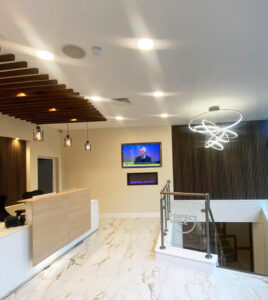Transforming a dental practice into a modern, patient-friendly environment requires far more than a simple refurbishment. Every surface, fixture, and layout decision must balance functionality, hygiene, and aesthetic appeal. That’s where dental surgery contractors play a crucial role — professionals who combine technical skill with design sensibility to bring seamless precision to every dental build. A dental clinic today is more than a workspace; it’s a reflection of trust, care, and innovation. From spatial planning to regulatory compliance, every element must support both patient experience and clinical performance. With thoughtful dental practice interior design, clinics can achieve that perfect balance of comfort, style, and efficiency — creating an atmosphere where patients feel at ease and practitioners perform at their best.
The Role of Dental Surgery Contractors in Modern Practice Development
The evolution of dental practice design has been dramatic. Modern clinics now prioritise functionality and aesthetics equally, requiring specialised contractors who understand both the clinical and architectural dimensions of the project. Dental surgery contractors bring together design expertise, compliance knowledge, and construction precision — ensuring every inch of the clinic serves a purpose.
- Unlike general contractors, dental specialists operate under precise technical and regulatory standards. They manage complex systems, infection control zones, and dental equipment layouts with accuracy to ensure seamless, compliant clinic construction.
- They have in-depth knowledge of infection control zones, precise air circulation standards, and seamless integration of advanced dental equipment for optimal performance.
- Their expertise enables them to transform a dentist’s vision into a fully compliant, highly functional, and aesthetically refined space that supports efficiency and patient comfort.
- Collaboration is key; contractors work closely with architects and designers to ensure that the project not only meets building regulations but also aligns with the clinic’s brand identity and operational needs.

Balancing Aesthetics and Functionality in Dental Practice Interior Design
A dental practice must be visually inviting while maintaining the highest standards of hygiene and efficiency. Dental practice interior design is about achieving harmony between aesthetics and function — every design decision contributes to how patients perceive care quality and how comfortably the team performs their duties.
An effective design considers layout zoning, natural light, air quality, and sound control. Materials like non-porous flooring, easy-to-clean surfaces, and anti-bacterial coatings are chosen to promote hygiene while keeping the environment warm and welcoming.
Key Design Considerations:
- Clear zoning between clinical and non-clinical areas
- Proper lighting — natural for calmness, artificial for precision
- Sound insulation for privacy and tranquillity
- Accessibility compliance to meet inclusive design standards
When these elements are planned effectively, a clinic feels less like a medical facility and more like a comforting, professional space that promotes well-being.
Importance of Compliance and Technical Precision
Compliance isn’t a choice — it’s the backbone of every dental construction project. Regulations such as CQC standards and HTM 01-05 guidelines exist to ensure patient safety and environmental health. Dental surgery contractors are well-versed in these standards and build every element — from waste disposal systems to sterilisation areas — with precision and accountability.
- Technical elements such as plumbing for dental chairs, precise electrical layouts, and efficient mechanical ventilation are vital for maintaining performance, safety, and compliance.
- Even minor errors in these systems can lead to costly, long-term issues, making professional oversight and precise installation absolutely essential.
- The right contractor ensures these elements integrate seamlessly, allowing clinicians to focus on patient care without worrying about operational disruptions.
Creating a Patient-Centric Environment
Patients often judge their experience long before they sit in the dental chair. The atmosphere of a clinic can greatly influence their sense of comfort and trust. A well-planned design uses soft lighting, gentle colours, and natural textures to reduce anxiety. Spacious waiting areas with calm décor can ease nervousness, while efficient room layouts reduce waiting times and crowding.
- A patient-centric approach also embraces modern technology — digital check-in kiosks, touchscreen displays, or calming background media.
- When incorporated intelligently, these features elevate the patient experience and portray the clinic as forward-thinking and professional.
Workflow Efficiency and Staff Productivity
The efficiency of a dental practice depends on how well it’s designed to support daily operations. Poor layout can lead to bottlenecks, fatigue, and unnecessary movement, while a smart interior can streamline workflow and boost morale.
Design elements that improve staff workflow:
- Ergonomically designed cabinetry for easy access
- Adjustable workstations suited for long procedures
- Logical arrangement of equipment for quick transitions
- Slip-resistant and easy-to-clean flooring
- Hidden yet accessible storage systems
When functionality aligns with design, staff enjoy smoother routines, and patients benefit from a more organised and confident service.
Sustainable and Future-Ready Dental Interiors
Sustainability is shaping the future of healthcare interiors. Clinics are embracing low-VOC paints, recycled materials, and energy-efficient LED lighting to reduce environmental impact. Natural ventilation, daylight optimisation, and motion-sensitive fixtures are also becoming common in dental practice interior design.
- Future-readiness ensures dental clinics can easily adapt to new technologies, digital systems, and modern workflows without major redesigns or disruptions.
- As technology advances, clinics must accommodate digital scanners, 3D imaging tools, and AI-based diagnostic systems.
- Designing adaptable spaces ensures that upgrading technology doesn’t require a complete redesign — a key advantage for long-term efficiency.

Choosing the Right Dental Surgery Contractor
Selecting the right contractor determines whether a vision becomes reality. Beyond cost, it’s essential to assess experience, industry knowledge, and project compatibility.
| Evaluation Criteria | Why It Matters |
| Industry Experience | Ensures familiarity with clinical regulations |
| Project Portfolio | Reveals design versatility and innovation |
| Collaboration Style | Encourages smooth communication |
| Compliance Expertise | Guarantees adherence to technical and safety standards |
Transparent communication, detailed proposals, and accountability throughout the project are non-negotiable traits. A reputable contractor won’t just build; they’ll consult, guide, and deliver excellence from concept to completion.
Conclusion
Modern dental environments are a perfect blend of precision, functionality, and elegance. Partnering with experienced dental surgery contractors ensures that every detail — from structural compliance to patient comfort — is handled with expert care. When paired with purposeful dental practice interior design, these clinics evolve into spaces that inspire confidence, support efficiency, and reflect professionalism. At Divo Interiors LTD, we combine design innovation with technical excellence to create bespoke dental clinics that enhance both patient experience and practitioner performance, redefining what a modern practice can be.

